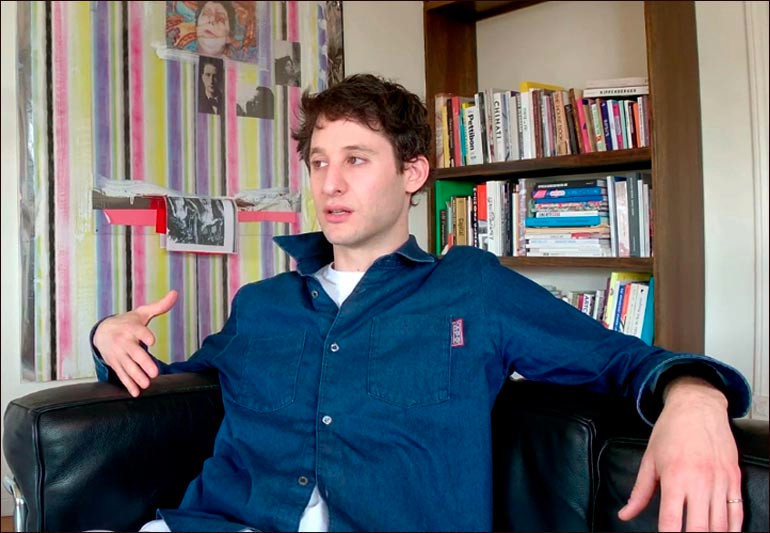[ad_1]
If Jordan Wolfson is an “edgelord,” our culture doesn’t have much of an edge. Spit Earth: Who Is Jordan Wolfson?, a new documentary directed by James Crump, nods at its start to the artist’s “offensiveness” and his lack of deference to “political correctness” and “virtue signaling.” But since the putatively offended parties are mostly absent from the 55-minute film, one can only imagine what sensitivities might be triggered by Wolfson’s vulgarity, scatology, violence, lust, and direct or sideways invocations of ethnicity, race, and racism. Maybe tweakings of these taboos count as offensive today, but not too long ago they were common currency.
So outside a certain bubble, Wolfson comes across less as a provocateur than as a sophisticated and entertaining nostalgia act, repackaging familiar transgressions in novel trappings like animatronics and virtual-reality headsets. Plenty of precursors beyond the two that Wolfson names (David Lynch and Jeff Koons) are obvious: Norman Mailer, R. Crumb, Al Goldstein, the Beastie Boys, Howard Stern. His 2014 breakout work (Female figure), an animatronic blonde who dances while looking in a mirror, channels ’50s-era pinups through pre-2001 robotics and the perverted masquerade of Kubrick’s Eyes Wide Shut. His VR installation from the 2017 Whitney Biennial, Real Violence, replays the street beatdown scene from A Clockwork Orange in black goggles with an anti-Semitic twist. As for the animated aging Jewish man in a yarmulke and beard talking dirty in in the artist’s voice in Animation, masks (2011), Woody Allen made the same joke in Annie Hall. Call Wolfson a transgressive traditionalist—and watch him drag such manchild signifiers as Pinocchio and Looney Toons into the piss and shit of a muddled 21st-century adulthood to a familiar pop score of Lady Gaga and Percy Sledge.
One function of virtue signaling is money laundering, since money has no virtue on its own and more often than not is born of vice (or worse). But if virtuous art pays out these days in return for the cover it provides to capital, it stands to reason that some money will flow to its opposite, especially if it comes in an ironic wrapping. If Wolfson were truly offensive, he’d be kicked out of polite society. But his irony affirms the status quo even as it points up its hypocrisies and general flimsiness. And so Spit Earth takes us to Wolfson’s farm house in upstate New York, where he enjoys the company of a couple of large dogs and keeps a pair of rescue horses in a big red barn. Wolfson cops that he’s always been “fortunate,” and we see childhood photos of his upper-middle-class family. But as usual, his checking of privilege comes across as a form of autofellatio thinly disguised as self-deprecation.
The best scenes of the film transpire in the living room: Wolfson putting his phone on the mantel and FaceTiming with an animator, acting out the scene he wants her to put on the screen for his next piece. He’s laughing, he’s dancing, he’s appreciative of his collaborator—all with the sense of childlike fun that enchants many of his works. Such scenes are more illuminating than anything the talking heads in the film say about him—though they’re all entranced by his charisma—or any of the vague things Wolfson says about his boyhood. “It was hard,” he tells us of growing up. “Jordan had a learning disability,” his mother explains. There’s a whiff of therapy to the proceedings, the couch no doubt being the source of a good deal of Wolfson’s inspiration. “No artist is comfortable in his own skin,” adds Wolfson’s aunt, the novelist Erica Jong. “Am I allowed to say that?”

Asking permission to utter a bromide nicely captures the tone of Spit Earth, but the supposed scandalousness of the art doesn’t quite eclipse the art itself. The drama at play is mostly of the messy-breakup variety. Wolfson’s ex-girlfriend Emma Fernberger, who is pictured nude in his embrace in one of his paintings, recalls how the picture hurt another ex-boyfriend’s feelings. She and Wolfson have since patched things up, and when Fernberger wonders aloud whether all of Wolfson’s work amounts to an elaborate psychic self-portrait, she’s stating the obvious.
Wolfson’s most striking transgression was a series of posters in which he called out the Venice Biennale for not selecting him for competition (nothing is more offensive than a careerism that dares to speak its own name) while also criticizing other artists for not “making work you love.” The image behind the text on them is something Wolfson surely loves: himself.
It’s hard to blame him. Wolfson has wit and energy. He does a funny impression of Jeff Koons. He’s clever and shrewd—maybe even too shrewd within an art world that’s allowed him to thrive more as jester than gadfly. The glibbest of Wolfson’s works is the new Artists, Friends, Racists (2020) in which the three words flicker alternately in neon read signage. To hear him explain the logic behind the piece—that any white person born in America might not be personally racist but is complicit in structural racism—only makes it drearier, since it’s conventional wisdom.
Wolfson could clearly use some competition as a satirist. But turning 40 this fall, his days as an enfant terrible are behind him. Spit Earth serves as a capstone to that phase. The table is set for a long midlife crisis.
Spit Earth: Who Is Jordan Wolfson? is now available online on Vimeo.
[ad_2]
Source link

